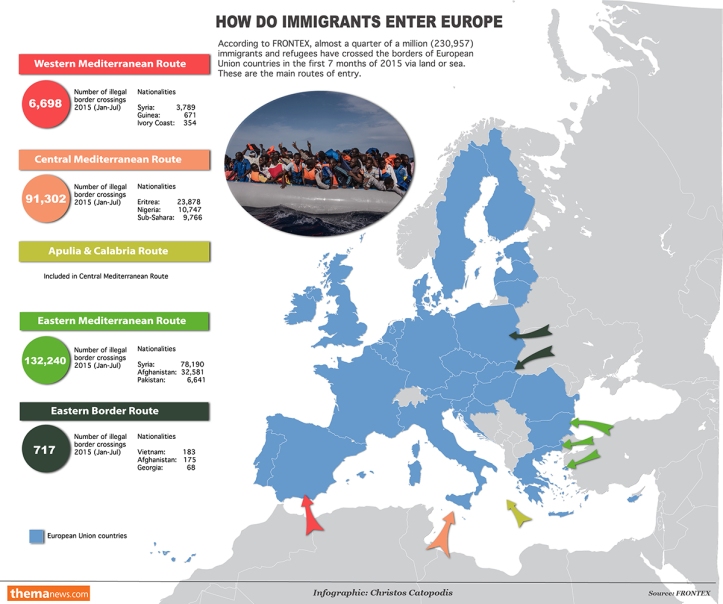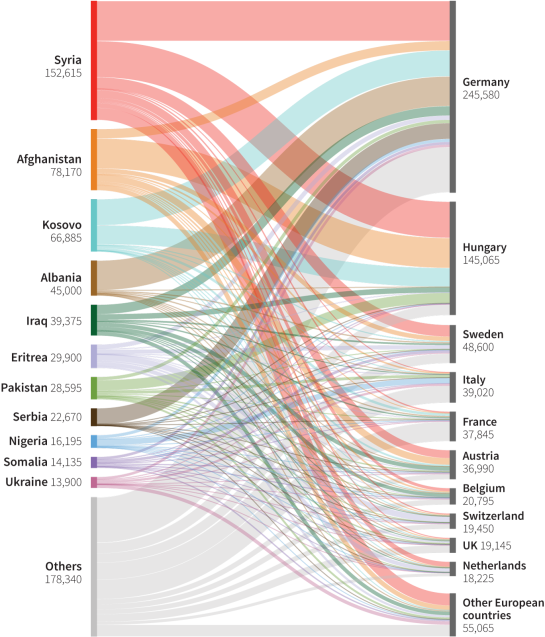Nowadays Europe is on the brink of a huge 21st century challenge: every single day thousands of migrants come to European countries by crossing the Balkans, Greece or Italian peninsula. First of all, it is fair to ask, why do people migrate? The majority of migrants take a decision in favor of dangerous and quite expensive journey for a combination of reasons. To a greater extent migration flows to European continent can be explained by “the rise of the rights-based liberalism” stimulus, attributing to migrants basic human rights (Hollifield, 2008). There is little likelihood that Syrian refugees will break a path to China (not free), for instance. The year of 2015 was spent on debating the migration issue that segued to the trend unlikely to lanquish in 2016.

http://en.protothema.gr/
According to the majority of the western media, the initial destination point of the refugees is Germany. What makes this European country so attractive? Mostly refugees and asylum seekers look for the safety and freedom legally ensured within the EU that they lost in the countries of their citizenship or in places of habitual residence, where the military actions broke out. If the number of asylum seekers to Germany in 2010 was 48 475, in the previous year this number estimated 202 645. According to the Residence Act of the Federative Republic of Germany, “a foreigner may not be deported to a state in which his or her life or liberty is under threat on account of his or her race, religion, nationality, membership of a certain social group or political convictions”. Once a person receives the refugee status, he/she is granted the same status as Germans (social welfare, child benefits, child-raising benefits, integration allowances and language courses).
Last August, the German government published the ten-point refugee policy that includes “a fair distribution of refugees in Europe.” Considering the ever-growing number of refugees, especially from Syria, once refused, Germany is now willing to return to the Dublin regulation, which emphasizes that refugees must apply for status acquisition in the first EU state they entered. However, the exception is stipulated to Greece, which is struggling with its debt crisis and possesses a weak asylum system. The Dublin regulation is fair enough from the burden-share perspective, however, several problems still arise such as the negatively patterned opinions about the idea of accepting refugees in certain countries, for instance in Hungary and Poland. In theory all 28 asylum systems work under the Common European Asylum System (CEAS), however the reality illustrates an unpromising situation, when particular countries impose unilateral restrictions like Austria.
As there is still a debate over the Dublin regulations’ application, another option for the refugee crisis solution is the cooperation with the third countries. The EU has already done it before, when it delegated the migration problem to Libya using the latter as a bouncer. Since many refugees are coming through the border of Turkey, the treaty conclusion with Ankara might contribute to the migrants’ flow limitation and stemming to European continent. In other words, the the third-party possibility might turn the existing chaos into control. Furthermore, the Malta summit took place on the 11-12th of November 2015, where more than 60 European and African countries agreed on the 16 concrete steps that include “the reinforcement of a State capacity to ensure security and fight terrorist threats” to be implemented “by the end of 2016 at the latest” – the idea of shared responsibility to the migrants’ issue was accepted. Apart from this, the country leaders decided to launch the Emergency Trust Fund for Africa with the purpose “to foster stability and to contribute to better migration management” (Action Plan). “We can put security measures in place, but the flow will remain difficult to stop as long as we don’t take measures to reduce poverty,” said the President of Nigeria. The Fund money, providing additional financial support, is exactly aimed at assurance of the proper economic conditions for returning the migrants back to Africa.
Do liberal democracies have enough capabilities to accept and control immigrants? Not only within the Federative Republic of Germany, but all over Europe the proponents of the Smithian liberalism (“market-oriented societies are capable of absorbing large numbers of immigrants”) and the Malthusian view (“every society has limited resources”) clash every time the tensions come, and it illustrates how the refugee issue can be proficiently used by the Merkel’s opponents to remove her from the European political Olympia (Hollifield, 2000). There is an arduous debate within Germany: the Christian Social Union’s (CSU) leader Horst Seehofer declared that “we will submit a written demand to the federal government to reestablish legally regulated conditions at the borders… If it does not do so, the Bavarian government will have no choice but to submit a complaint to the Federal Constitutional Court.” The intensification of the refugee crisis issue in Germany seems to be a response to the little progress of Merkel’s plan.
According to the Eurobarometer opinion poll at the beginning of 2015, half of surveyed Germans welcomed immigration from other EU member states. However, only more than a quarter of Germans have a positive opinion of immigration from outside the EU. Does it indicate that Germans are afraid of losing their national identity? Fair enough to assume that hospitability or hostility within the society towards foreigners triggers a reaction of integration or segregation strategy, respectively: when natives feel secure in their identity, they will strike a pose to accept the ones who differ from them. On the contrary, in case of insecurity they will show the negative attitude. In this context the word security includes the realization of social, economic and political rights alongside with recognition and respect of another group’s identity and sense of belonging that include language, cultural values and beliefs, customs etc. Security assurance leads to “others” acceptance. Addressing the changing cultural identity of many European countries, the question of tolerance in society arises. Specifically, the current refugee crisis in Europe once again provoked the latest activity of anti-immigrants’ movements such as PEGIDA (Patriotic Europeans Against the Islamization of the Occident) and HOGESA (Hooligans against Salafists) in Germany. The similar wave of the right-wing parties’ public appearance can be observed: Alternative für Deutschland (Germany), the National Front (France), the Party of Freedom (Netherlands) and the Danish People’s Party (Denmark) where populists categorize the migration itself into the securitization realm to be perceived as an existential threat, when the media spread the news utilizing metaphors like the uncontrolled spread of “terrorism web” etc. In this context societal insecurities take precedence over the military concerns, placing in the forefront migration within identity concerns.
Neoliberal institutionalist perspective suggests that migrants pursue destinations in democratic states, where the standards of living are higher, economy is growing and human rights are guaranteed to everyone. However, depending on the regime type, a state adopts either restrictionist or expansionist policies. Nowadays countries, especially developed ones, construct the narratives of the strongest control of their borders to fence off undesirable public. Eventually the immigration policy from the “low politics” evolve into the “high politics” nowadays as the official migration discourse goes into the new phase of development, when almost all states take actions towards the pragmatic decision in favor of the “controlled” migration primarily because of political and social reasons. The questions are still pending: What should the EU do next? Is there a need for the global approach?
Asylum seekers in Europe (From January to August 2015,(unless indicated otherwise*)
**Latest data available for Czech Republic, Denmark, Estonia, Ireland, Greece, France, Italy, Latvia, Malta, Austria, Portugal, Romania, Slovakia, Finland, UK, and Iceland is for July. Latest data available for Spain, Cyprus and Liechtenstein is for the month of June. Eurostat data as of Oct. 2

http://graphics.thomsonreuters.com/15/migrants/index.html#section-asylum
Reference: Hollifield, J. F. 2008. “The Politics of International Migration: How Can We ‘Bring the State Back In’.” In Migration Theory: Talking Across Disciplines, ed., C. B. Brettell and J. F. Hollifield. New York/London, Routledge.
Written by Madina Bizhanova